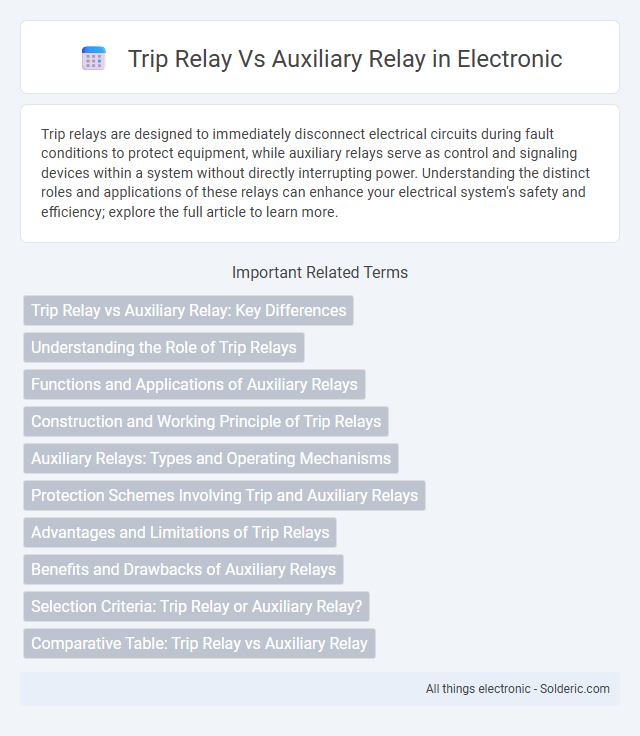Trip relays are designed to immediately disconnect electrical circuits during fault conditions to protect equipment, while auxiliary relays serve as control and signaling devices within a system without directly interrupting power. Understanding the distinct roles and applications of these relays can enhance your electrical system's safety and efficiency; explore the full article to learn more.
Comparison Table
| Feature | Trip Relay | Auxiliary Relay |
|---|---|---|
| Primary Function | Initiates circuit breaker trip during fault conditions | Supports control circuits, provides signal or status feedback |
| Operation | Directly triggers circuit breaker opening | Does not trip breaker; used for indication and control |
| Application | Protection system for power system faults | Control panels, interlocking, auxiliary signaling |
| Contact Configuration | Typically normally closed (NC) or normally open (NO) contacts to trip breakers | Multiple contact types; flexible for control circuits |
| Response Time | Fast response to fault conditions | Moderate response for control operations |
| Voltage Rating | Usually higher voltage rating for breaker coil operation | Lower voltage rating suitable for control circuits |
| Example Use | Breaker trip and protection trip signal | Alarm signaling, interlocking, control logic |
Trip Relay vs Auxiliary Relay: Key Differences
Trip relays are specialized devices designed to interrupt electrical circuits by activating circuit breakers during fault conditions, ensuring system protection and preventing equipment damage. Auxiliary relays serve as supplemental control elements that provide signal amplification, logic processing, or operational status feedback without directly tripping circuits. The primary difference lies in their function: trip relays execute protective actions to isolate faults, while auxiliary relays support control schemes and relay coordination within electrical systems.
Understanding the Role of Trip Relays
Trip relays serve as critical components in electrical protection systems by triggering circuit breakers to disconnect power during fault conditions, ensuring system safety and preventing equipment damage. Unlike auxiliary relays, which primarily perform control and signaling functions without directly causing disconnection, trip relays have a direct impact on the operation of protection devices. Your ability to correctly identify and utilize trip relays enhances the reliability and responsiveness of electrical installations under abnormal events.
Functions and Applications of Auxiliary Relays
Auxiliary relays primarily function to amplify signals, provide isolation, and perform logical operations within control circuits, making them essential for complex automation setups. Unlike trip relays that activate protective mechanisms during fault conditions, auxiliary relays are widely applied in sequential control, interlocking, and indication systems across industrial and commercial electrical panels. Their versatility in handling low power signals ensures reliable operation of larger power devices, enhancing system efficiency and safety.
Construction and Working Principle of Trip Relays
Trip relays are constructed with robust contacts and coil designed to interrupt electrical circuits during fault conditions; their working principle involves energizing the coil upon detecting abnormal current or voltage, causing the contacts to open and trip the circuit breaker. Auxiliary relays have simpler construction with contacts intended for signaling or control purposes, operating by energizing the coil to close or open contacts without directly interrupting power circuits. Trip relays prioritize rapid disconnection in protection systems, while auxiliary relays assist in control logic and indication functions.
Auxiliary Relays: Types and Operating Mechanisms
Auxiliary relays include types such as electromagnetic, solid-state, and reed relays, each designed to perform control, signaling, and switching functions in electrical circuits. Their operating mechanisms involve energizing a coil to actuate internal contacts, enabling them to manage low-power signals or interface with control devices. These relays serve crucial roles in amplifying control signals, providing electrical isolation, and ensuring reliable operation in protection and automation systems.
Protection Schemes Involving Trip and Auxiliary Relays
Trip relays serve as critical components in protection schemes by initiating circuit breaker operation to isolate faults, ensuring system safety and preventing equipment damage. Auxiliary relays support these schemes by providing necessary signaling, interlocking, and control functions, enhancing overall relay logic and reliability. Your protection system relies on the coordinated interaction of trip and auxiliary relays to maintain stability and rapid fault clearance.
Advantages and Limitations of Trip Relays
Trip relays provide rapid disconnection of electrical circuits during fault conditions, enhancing system protection and minimizing equipment damage. Their high sensitivity and reliability ensure precise fault isolation, but they require careful coordination to prevent nuisance tripping and may involve higher installation costs. Trip relays are limited by their dependence on accurate fault detection signals and potential complexity in multi-relay systems.
Benefits and Drawbacks of Auxiliary Relays
Auxiliary relays offer benefits such as reduced load on the main control circuit and enhanced flexibility in controlling multiple devices through a single input signal. They provide improved isolation between control and power circuits, which increases system reliability and safety. However, auxiliary relays may introduce slight delays in response time and add complexity to the wiring, potentially increasing maintenance requirements.
Selection Criteria: Trip Relay or Auxiliary Relay?
Trip relay selection prioritizes immediate disconnection and fault protection in electrical circuits, requiring high reliability, fast response time, and the ability to handle high fault currents. Auxiliary relay choice depends on control signal amplification, sequencing, and logic functions, emphasizing flexibility, low power consumption, and compatibility with control systems. Optimal relay selection hinges on the specific application demands, with trip relays for critical safety functions and auxiliary relays for control and monitoring tasks.
Comparative Table: Trip Relay vs Auxiliary Relay
Trip relays are essential for interrupting electrical circuits in response to faults, offering rapid disconnection to protect equipment and ensure safety, whereas auxiliary relays primarily provide control logic and signal amplification within control circuits. Trip relays typically operate at higher current ratings and are designed for immediate action under fault conditions, while auxiliary relays handle lower power signals and support various control functions. The comparative table highlights differences in purpose, operational current, response time, and application, with trip relays focusing on protection and auxiliary relays on control and monitoring tasks.
Trip relay vs auxiliary relay Infographic

 solderic.com
solderic.com